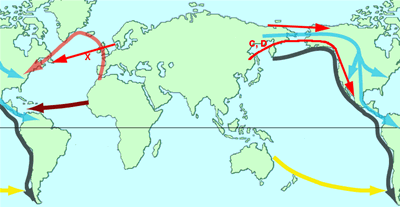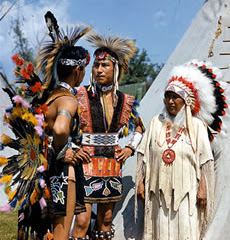There is considerable controversy and little consensus on the questions of when, where, and how human beings first arrived in and peopled the Americas. For much of the 20th century (c. 1920s–80s) the views of Aleš Hrdlicka (1869–1943) of the United States National Museum dominated the discipline of physical anthropology in the Americas. Hrdlicka and his followers maintained that all indigenous peoples of the Americas originated in north Asia from Mongoloid stock.
His theory dovetailed with the so-called Clovis-First hypothesis, a pre-1990s consensus among North American archaeologists and physical anthropologists that the ancestors of all peoples who inhabited the Americas prior to the European encounter in 1492 had migrated across a land bridge at the Bering Strait (called Beringia) and south through an ice-free corridor near the end of the most recent (or Wisconsin) glaciation, around 10,000 b.c.e. These early Paleo-Indians then dispersed across the Americas.
Their immediate descendants, the Clovis culture, employed a characteristic lithic chipping technique (first discovered near Clovis, New Mexico, in the 1930s), which then became widespread across North America. In this Clovis-First hypothesis, the Clovis culture was followed by the Folsom culture and subsequent late Paleo-Indian cultures.
  |
Numerous pre-Clovis sites excavated from the 1990s conclusively demonstrate human habitation of the Americas well before the Clovis horizon. New subdisciplines (including paleobotany, paleoparasitology, paleoclimatology, paleoecology, and mitochondrial DNA [mtDNA] analysis) and new dating technologies (especially more refi ned radiocarbon dating procedures and optically stimulated luminescence [OSL]) have pushed back the date of human habitation in the Americas to at least 16,000 BP (before present).
Paralleling the torturous history of paleoanthropology in Africa and Asia, however, credible schools of thought regarding the peopling of the Americas are varied, multiple, contradictory, and a matter of fierce debate.
In North America, and despite these disagreements, one consensus to emerge by the early 2000s was that the U.S. South and the Mid-Atlantic region south of the Wisconsin glaciation were major sites of human habitation in the pre-Clovis era. Numerous sites there predating the Clovis culture have been carefully excavated since the 1980s.
These include the Meadowcroft Rockshelter in southwestern Pennsylvania, a project directed by James M. Adovasio of the Mercyhurst Archaeological Institute, which has yielded firm dates of 16,000 BP; Cactus Hill, Virginia, led (in separate projects) by Joseph McAvoy of the Nottaway River Survey and Michael Johnson of the Archaeological Society of Virginia, whose human artifacts were also dated to around 16,000 BP; Saltville, Virginia, dated to 14,000 BP; and the Topper site in South Carolina, dated to at least 16,000 BP.
Another important project from the 1990s has been the Gault site excavation in central Texas, supervised by Mike Collins under the auspices of the Texas Archaeological Research Laboratory, which has unearthed more than half a million Clovis artifacts and shed new light on this mysterious culture.
In South America sites antecedent to Clovis include the Monte Verde project in Chile, undertaken by U.S. archaeologist T. D. Dillehay in the 1980s and 1990s; the Taima Taima project in Venezuela, led by Canadian archaeologists Alan Bryan and Ruth Gruhn from the 1970s; and the Pedra Furada project in northeastern Brazil, directed by Brazilian anthropologist Niède Guidon of the Fundação Museu do Homem Americano (FUMDHAM) since the 1980s.
Dillehay’s findings at Monte Verde demonstrate that humans inhabited the southernmost parts of South America at least 12,500 years ago and suggest dates as far back as 33,000 BP. The findings of Guidon and colleagues at Pedra Furada appear to push the date of human habitation of the Americas back even further.
Radiocarbon dating of hearth samples and other artifacts (using accelerator mass spectrometry [AMS] and a procedure called acid-base-wet oxidation followed by stepped combustion [ABOX-SC], developed in 1999) has yielded dates ranging from 35,000 to 55,000 b.c.e. for the Pedra Furada site.
Some purported anthropogenic specimens have yielded ages greater than 56,000 BP, the outermost limit of radiocarbon dating. Guidon and her colleagues therefore hypothesize that humans inhabited Pedra Furada and adjacent sites some 60,000 years ago, and perhaps before. Few scholars accept these very early dates.
Other evidence suggests South Asian, African, and possibly European migrations to the Americas in the pre-Clovis era. Among the most controversial findings is the so-called Kennewick Man, plucked out of the Columbia River in Washington State and dated to around 9,300 BP, to which some attributed "Caucasoid-like", or non–Native American Indian, anatomical features, sparking a huge debate and much litigation.
Less disputed is the skeleton dubbed "Luzia" in Brazil, which dates to around 10,000 b.c.e. and is considered to exhibit either African or South Asian morphological features.
Other reputable studies provide evidence of close anatomical affinities between contemporary and pre-Columbian Amerindians in the Baja California Peninsula and South Asian/South Pacific populations.
MtDNA analysis likewise elicits complex depictions of the genetic heritage of various pre-Columbian indigenous peoples of the Americas, suggesting not only North Asian but also South Asian, African, and European genetic links.
Other anomalies not explained by the Clovis-First hypothesis are the greater antiquity and relative abundance of pre-Columbian remains and artifacts in zones furthest from the Beringia land bridge and the more recent provenance and relative dearth of such remains in the zones nearest to it.
Linguistic analyses, too, suggest that people arrived in the Americas in several distinct migrations, not all from North Asia, the earliest dating to at least 15,000 b.c.e.
One plausible theory, that people arrived in waves of migrations over many millennia, beginning with watercraft migrations from Asia to the Pacific coasts of North and South America sometime between 30,000 and 20,000 BP, cannot be confirmed except through undersea archaeological digs (which do not exist in this field) or chance discovery, since the then-littoral was inundated by rising seas at the beginning of the Holocene (10,000 BP).
The most significant obstacles to further advances in this field include academic infighting among the proponents of various schools of thought, and linguistic and cultural barriers between North and South American scholars.
Some also view the 1990 U.S. Native American Graves Protection and Repatriation Act (NAGPRA) as a significant impediment to scientific research in North America, since it requires all pre-Columbian human remains and artifacts be repatriated to the closest culturally affiliated American Indian tribe recognized by the U.S. government, thereby precluding scientific testing, as occurred in the case of Kennewick Man.
Others point to the long history of routine mistreatment of unearthed human remains by physical anthropologists and archaeologists and to the spiritual well-being of contemporary Indian communities as necessitating NAGPRA.
Among the most reputable English-language scholarly journals in this rapidly expanding and contentious field are American Antiquity, Nature, Science, Athena Review, and North American Archaeologist.














